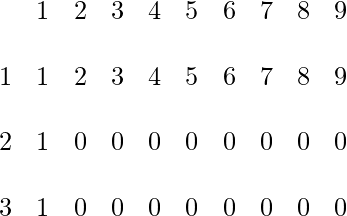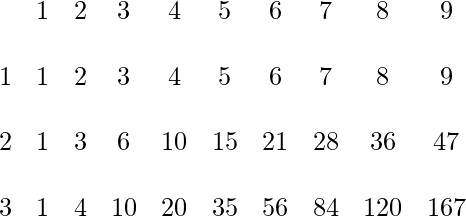Llame monótono a un número decimal si: ![]() . Escriba un programa que tome un número positivo n en la entrada y devuelva una cantidad de números decimales de longitud n que sean monótonos. Los números no pueden comenzar con 0. Ejemplos:
. Escriba un programa que tome un número positivo n en la entrada y devuelva una cantidad de números decimales de longitud n que sean monótonos. Los números no pueden comenzar con 0. Ejemplos:
Input : 1 Output : 9 Numbers are 1, 2, 3, ... 9 Input : 2 Output : 45 Numbers are 11, 12, 13, .... 22, 23 ...29, 33, 34, ... 39. Count is 9 + 8 + 7 ... + 1 = 45
Explicación: Comencemos con un ejemplo de números monótonos: ![]() todos esos números son monótonos ya que cada dígito en un lugar más alto es
todos esos números son monótonos ya que cada dígito en un lugar más alto es ![]() el anterior. ¿Cuáles son los números monótonos de longitud 1 y dígitos 1 o 2? Es una pregunta que debe hacerse desde el principio. Podemos ver que los números posibles son:
el anterior. ¿Cuáles son los números monótonos de longitud 1 y dígitos 1 o 2? Es una pregunta que debe hacerse desde el principio. Podemos ver que los números posibles son: ![]() Eso fue fácil, ahora ampliemos la pregunta a los dígitos 1, 2 y 3:
Eso fue fácil, ahora ampliemos la pregunta a los dígitos 1, 2 y 3: ![]() Ahora una pregunta diferente, ¿cuáles son los diferentes números monótonos que consisten en solo 1 y longitud 3 que hay?
Ahora una pregunta diferente, ¿cuáles son los diferentes números monótonos que consisten en solo 1 y longitud 3 que hay? ![]() Intentemos ahora dibujar esta observación muy simple en una array bidimensional para el número de longitud 3, donde la primera columna es la longitud de la string y la primera fila son los dígitos posibles:
Intentemos ahora dibujar esta observación muy simple en una array bidimensional para el número de longitud 3, donde la primera columna es la longitud de la string y la primera fila son los dígitos posibles:  Intentemos llenar la tercera fila, la tercera columna (cantidad de números monótonos que consisten en los números 1 o 2 con una longitud de 2). Esto debería ser:
Intentemos llenar la tercera fila, la tercera columna (cantidad de números monótonos que consisten en los números 1 o 2 con una longitud de 2). Esto debería ser: ![]() Si miramos más de cerca, ya tenemos subconjuntos de este conjunto, es decir:
Si miramos más de cerca, ya tenemos subconjuntos de este conjunto, es decir: ![]() – Números monótonos que tienen una longitud de 2 y consisten en 1 o 2
– Números monótonos que tienen una longitud de 2 y consisten en 1 o 2 ![]() – Números monótonos de longitud 2 y que consisten en el número 2 Solo necesitamos agregar los valores anteriores a conseguir el más largo. La array final debería verse así:
– Números monótonos de longitud 2 y que consisten en el número 2 Solo necesitamos agregar los valores anteriores a conseguir el más largo. La array final debería verse así: 
C++
// CPP program to count numbers of n digits
// that are monotone.
#include <cstring>
#include <iostream>
// Considering all possible digits as {1, 2, 3, ..9}
int static const DP_s = 9;
int getNumMonotone(int len)
{
// DP[i][j] is going to store monotone numbers of length
// i+1 considering j+1 digits.
int DP[len][DP_s];
memset(DP, 0, sizeof(DP));
// Unit length numbers
for (int i = 0; i < DP_s; ++i)
DP[0][i] = i + 1;
// Single digit numbers
for (int i = 0; i < len; ++i)
DP[i][0] = 1;
// Filling rest of the entries in bottom
// up manner.
for (int i = 1; i < len; ++i)
for (int j = 1; j < DP_s; ++j)
DP[i][j] = DP[i - 1][j] + DP[i][j - 1];
return DP[len - 1][DP_s - 1];
}
// Driver code.
int main()
{
std::cout << getNumMonotone(10);
return 0;
}
// This code is contributed by Sania Kumari Gupta
C
// C program to count numbers of n digits
// that are monotone.
#include <stdio.h>
#include <string.h>
// Considering all possible digits as
// {1, 2, 3, ..9}
int static const DP_s = 9;
int getNumMonotone(int len)
{
// DP[i][j] is going to store monotone numbers of length
// i+1 considering j+1 digits.
int DP[len][DP_s];
memset(DP, 0, sizeof(DP));
// Unit length numbers
for (int i = 0; i < DP_s; ++i)
DP[0][i] = i + 1;
// Single digit numbers
for (int i = 0; i < len; ++i)
DP[i][0] = 1;
// Filling rest of the entries in bottom up manner.
for (int i = 1; i < len; ++i)
for (int j = 1; j < DP_s; ++j)
DP[i][j] = DP[i - 1][j] + DP[i][j - 1];
return DP[len - 1][DP_s - 1];
}
// Driver code.
int main()
{
printf("%d", getNumMonotone(10));
return 0;
}
// This code is contributed by Sania Kumari Gupta
Java
// Java program to count numbers
// of n digits that are monotone.
class GFG
{
// Considering all possible
// digits as {1, 2, 3, ..9}
static final int DP_s = 9;
static int getNumMonotone(int len)
{
// DP[i][j] is going to store
// monotone numbers of length
// i+1 considering j+1 digits.
int[][] DP = new int[len][DP_s];
// Unit length numbers
for (int i = 0; i < DP_s; ++i)
DP[0][i] = i + 1;
// Single digit numbers
for (int i = 0; i < len; ++i)
DP[i][0] = 1;
// Filling rest of the entries
// in bottom up manner.
for (int i = 1; i < len; ++i)
for (int j = 1; j < DP_s; ++j)
DP[i][j] = DP[i - 1][j]
+ DP[i][j - 1];
return DP[len - 1][DP_s - 1];
}
// Driver code.
public static void main (String[] args)
{
System.out.println(getNumMonotone(10));
}
}
// This code is contributed by Ansu Kumari.
Python3
# Python3 program to count numbers of n
# digits that are monotone.
# Considering all possible digits as
# {1, 2, 3, ..9}
DP_s = 9
def getNumMonotone(ln):
# DP[i][j] is going to store monotone
# numbers of length i+1 considering
# j+1 digits.
DP = [[0]*DP_s for i in range(ln)]
# Unit length numbers
for i in range(DP_s):
DP[0][i] = i + 1
# Single digit numbers
for i in range(ln):
DP[i][0] = 1
# Filling rest of the entries
# in bottom up manner.
for i in range(1, ln):
for j in range(1, DP_s):
DP[i][j] = DP[i - 1][j] + DP[i][j - 1]
return DP[ln - 1][DP_s - 1]
# Driver code
print(getNumMonotone(10))
# This code is contributed by Ansu Kumari
C#
// C# program to count numbers
// of n digits that are monotone.
using System;
class GFG
{
// Considering all possible
// digits as {1, 2, 3, ..9}
static int DP_s = 9;
static int getNumMonotone(int len)
{
// DP[i][j] is going to store
// monotone numbers of length
// i+1 considering j+1 digits.
int[,] DP = new int[len,DP_s];
// Unit length numbers
for (int i = 0; i < DP_s; ++i)
DP[0,i] = i + 1;
// Single digit numbers
for (int i = 0; i < len; ++i)
DP[i,0] = 1;
// Filling rest of the entries
// in bottom up manner.
for (int i = 1; i < len; ++i)
for (int j = 1; j < DP_s; ++j)
DP[i,j] = DP[i - 1,j]
+ DP[i,j - 1];
return DP[len - 1,DP_s - 1];
}
// Driver code.
public static void Main ()
{
Console.WriteLine(getNumMonotone(10));
}
}
// This code is contributed by vt_m.
PHP
<?php
// PHP program to count numbers
// of n digits that are monotone.
function getNumMonotone($len)
{
// Considering all possible
// digits as {1, 2, 3, ..9}
$DP_s = 9;
// DP[i][j] is going to store
// monotone numbers of length
// i+1 considering j+1 digits.
$DP = array(array_fill(0, $len, 0),
array_fill(0, $len, 0));
// Unit length numbers
for ($i = 0; $i < $DP_s; ++$i)
$DP[0][$i] = $i + 1;
// Single digit numbers
for ($i = 0; $i < $len; ++$i)
$DP[$i][0] = 1;
// Filling rest of the entries
// in bottom up manner.
for ($i = 1; $i < $len; ++$i)
for ($j = 1; $j < $DP_s; ++$j)
$DP[$i][$j] = $DP[$i - 1][$j] +
$DP[$i][$j - 1];
return $DP[$len - 1][$DP_s - 1];
}
// Driver code
echo getNumMonotone(10);
// This code is contributed by mits
?>
Javascript
<script>
// JavaScript program to count numbers of n
// digits that are monotone.
// Considering all possible digits as
// {1, 2, 3, ..9}
let DP_s = 9
function getNumMonotone(ln){
// DP[i][j] is going to store monotone
// numbers of length i+1 considering
// j+1 digits.
let DP = new Array(ln).fill(0).map(()=>new Array(DP_s).fill(0))
// Unit length numbers
for(let i=0;i<DP_s;i++){
DP[0][i] = i + 1
}
// Single digit numbers
for(let i=0;i<ln;i++)
DP[i][0] = 1
// Filling rest of the entries
// in bottom up manner.
for(let i=1;i<ln;i++){
for(let j=1;j<DP_s;j++){
DP[i][j] = DP[i - 1][j] + DP[i][j - 1]
}
}
return DP[ln - 1][DP_s - 1]
}
// Driver code
document.write(getNumMonotone(10),"</br>")
// This code is contributed by shinjanpatra
</script>
Producción :
43758
Publicación traducida automáticamente
Artículo escrito por Mateusz_Wojtczak y traducido por Barcelona Geeks. The original can be accessed here. Licence: CCBY-SA